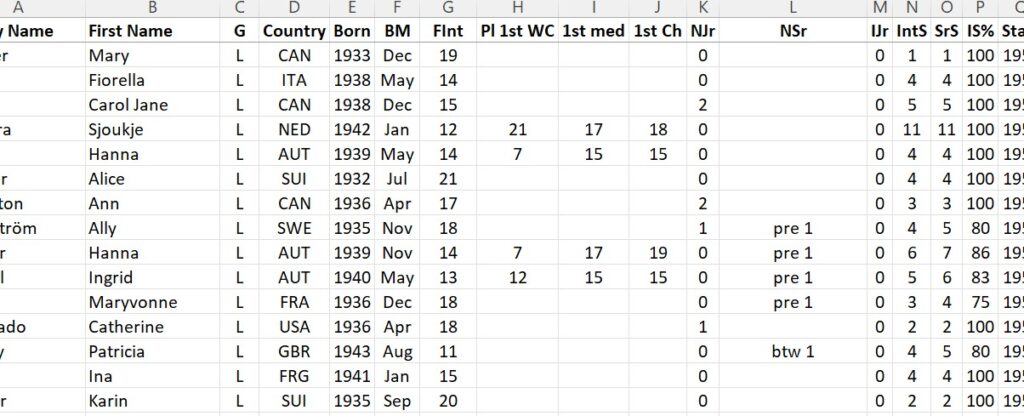How can you study competetive careers? This post is about how I went about to do it…
My aim was to study the career development of singles skaters and their age in its different stages. The material used consists of competitive careers of singles skaters who participated in the ISU World Championships from 1947 through to 2022.

The lists of participants in each championship are available fairly reliably in Wikipedia. Most of the skaters also have their own Wikipedia entries with information on their competitive careers. Only elite skaters could get to the Worlds and their careers are usually well documented. However, no material is ever complete and perfect, there are always problems.
Firstly, there is always a possibility that the results lists do not contain all the participants. But it is difficult to know which ones might be partial. These lists contain the names, nationalities, and the results for the skaters, but that is of course not enough to study the careers. It is necessary to have a bit of personal data such as date of birth and more information on their competitive career.
The second problem is that there are differences in the data included in the Wikipedia pages, ISU biographies, or other sources for each skater. The current ones are documented much more thoroughly than the ones until the 1990s. For example, data on international competitions beyond the major championships really start to appear in the 1980s though some events were organized annually before that. Regular major international junior competitions start to appear in the late 1980s and 1990s, but they are not necessarily listed in the Wikipedia entries. Finding data on minor junior competitions is difficult until quite recently.
The basic requirement was to have at least the year of birth in addition to some information on the competitions they participated in. I included everyone with enough data.
This means that the collection I used in the analyses is a sample of the whole pool of skaters. Over 880 women and over 630 men participated in the Worlds from 1947 to 2022, and it was possible to include about 70 % of the women and 81 % of the men. The year of birth could not be found in average for 10–20 % of the participants per year, smaller numbers with men than women. There was usually missing data was for skaters who were not particularly successful in their careers – less than 10 % participated in more than one Worlds.
Chronologically, most of the excluded skaters were active in the 1970s to 1990s. Very few of the 21st century skaters needed to be left out. There were no notable geographical differences between skaters from different countries – data for skaters from big and small nations could not be found equally commonly.
Overall, the final data collection is slightly skewed towards more successful and more recent skaters, but as well over half of them could be included, it is a good sample of them all. The table below shows what the numbers of included and excluded skaters look like:
| Total | Included | Excluded | |
| Women | 884 | 624 (71 %) | 260 (29 %) |
| Men | 632 | 512 (81 %) | 120 (19 %) |
A list of participants of World Championships was created on a spreadsheet, and in it, the following things were noted for all skaters:
- name, country, year of birth, month of birth;
- year of the first international senior competition;
- year of the last international senior competition;
- age at the start of international senior career;
- age at the end of international senior career;
- number of seasons in international seniors;
- number of seasons in international juniors when there are no international senior competitions;
- number of seasons in national juniors and seniors if there are no international competitions at the same time.
I also used the skater’s success as part of the analyses: non-medalists, medalists, and those who became champions. For those who medaled or won major competitions (Europeans, Four Continents, Grand Prix Final, Worlds, Olympics), I also noted the following bits of information:
- placement at first Worlds;
- age at 1st medal at a major competition;
- age at 1st victory at a major competition.
Determining when skaters turn senior can be surprisingly difficult – these days many skate in both junior and senior competitions simultaneously. In this study, the senior career starts simply when they first enter an international senior competition. They might participate in junior competitions during that time and even after their last senior competition, but in this data set, they are regarded as senior. The number of junior seasons marks those when they do not participate in senior competitions at all.
Based on all the changes taking place in the 1990s (see more on that in the introduction here), I divided the skaters in three chronological groups:
- those who began their careers before 1993–1994;
- those who began 1993–1994 or after and have retired;
- those who skate competitively currently.
The last group might include some skaters that have retired as not everyone announces their retirement or the retirement does not get recorded in the available sources. But if there are no results after the 2020–21 season, I have regarded them as likely to have stopped skating competitively.
The basic numbers of skaters in each group look like this:
| Chronological Group | Women | Men |
| Started before 1993–94 | 288 | soon |
| Started in/after 1993–94 and retired | 286 | soon |
| Competing currently | 50 | soon |
| Total | 624 | 512 |
I will add links to the different posts as they get published!